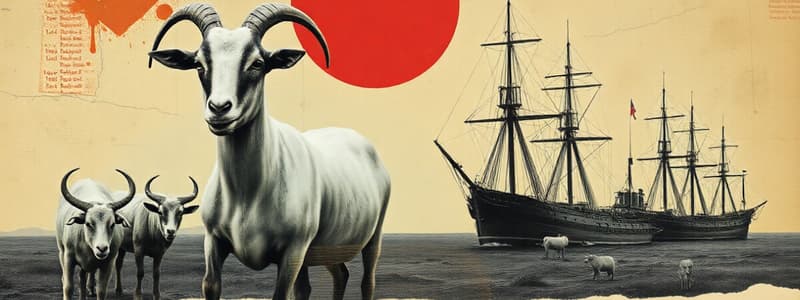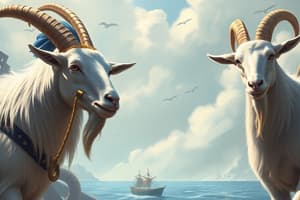Podcast
Questions and Answers
Why were goats kept on ships?
Why were goats kept on ships?
- For fresh meat and milk (correct)
- As pets for the crew
- For wool production
- To pull carts on board
Which animal was NOT mentioned in the provided content as being kept on ships?
Which animal was NOT mentioned in the provided content as being kept on ships?
- Goats
- Hens
- Oxen
- Pigs (correct)
What health problem did oxen face on ships?
What health problem did oxen face on ships?
- Broken Legs
- Scurvy (correct)
- Sea sickness
- Dehydration
Which type of weather was suitable for hens to prosper?
Which type of weather was suitable for hens to prosper?
Which animal was able to maintain 'sea legs?'
Which animal was able to maintain 'sea legs?'
Flashcards
Scurvy
Scurvy
A disease caused by vitamin C deficiency, common among sailors.
Livestock on ships
Livestock on ships
Fresh meat and milk source on early ships.
Livestock that thrived at sea
Livestock that thrived at sea
Goats.
Livestock susceptible to scurvy
Livestock susceptible to scurvy
Signup and view all the flashcards
Why hens weren't ideal
Why hens weren't ideal
Signup and view all the flashcards
Study Notes
- In the early days of the service, larger ships kept goats and other livestock to have fresh meat and milk.
- Not all livestock were able to survive at sea.
- Oxen were vulnerable to scurvy.
- Sheep did not generally thrive in a sea environment.
- Hens only did well when the weather was good.
- Goats were the only livestock able to maintain “sea legs,” in any weather, and under all conditions.
Studying That Suits You
Use AI to generate personalized quizzes and flashcards to suit your learning preferences.





